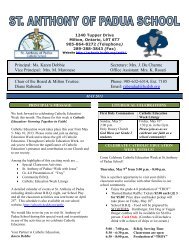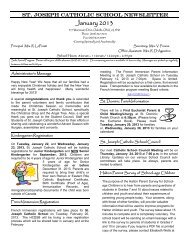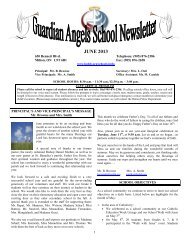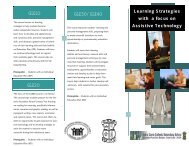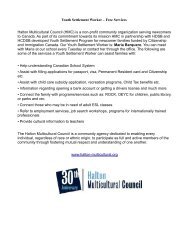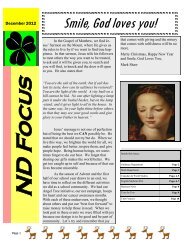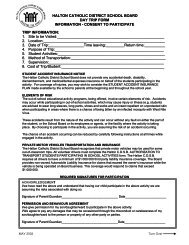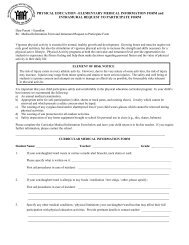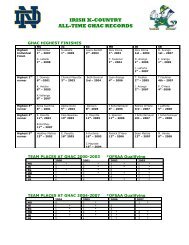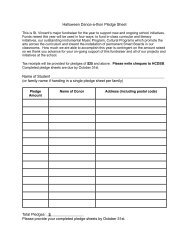Daily Physical Activity in Schools
Daily Physical Activity in Schools
Daily Physical Activity in Schools
You also want an ePaper? Increase the reach of your titles
YUMPU automatically turns print PDFs into web optimized ePapers that Google loves.
Introduction<br />
Outl<strong>in</strong>e of the Activities<br />
The activities provided <strong>in</strong>clude a warm-up, moderate to vigorous physical activity,<br />
and a cool-down. These activities can be used throughout the year. Repetition of a<br />
daily physical activity – five or six times dur<strong>in</strong>g the course of a month, for example –<br />
allows students to become familiar with the activity, and reduces the time required for<br />
<strong>in</strong>struction <strong>in</strong> the activity. As a result, students have more time to be physically active.<br />
Teachers can create variations on the activities, and can also encourage students to<br />
create their own variations.<br />
Warm-up<br />
It is important that students do a warm-up before start<strong>in</strong>g daily physical activities.<br />
A proper warm-up sets the tone for the class and reduces the risk of <strong>in</strong>jury dur<strong>in</strong>g an<br />
activity. To warm up, students should participate <strong>in</strong> some low-<strong>in</strong>tensity aerobic activity,<br />
such as brisk walk<strong>in</strong>g. Us<strong>in</strong>g the large muscles and gradually <strong>in</strong>creas<strong>in</strong>g speed and<br />
<strong>in</strong>tensity <strong>in</strong> this type of activity gradually <strong>in</strong>creases the heart rate and blood flow to<br />
the muscles. Dur<strong>in</strong>g the warm-up, it is important to follow up with stretches that move<br />
the jo<strong>in</strong>ts through their full range of motion. Stretches such as arm circles and flex<strong>in</strong>g<br />
and extend<strong>in</strong>g of the arms and legs are helpful.<br />
Moderate to Vigorous <strong>Physical</strong> <strong>Activity</strong><br />
The physical activities <strong>in</strong> this resource guide are examples of moderate to vigorous<br />
physical activities. It is important to ensure that students participate <strong>in</strong> the activities <strong>in</strong><br />
an appropriate manner, work<strong>in</strong>g towards <strong>in</strong>creas<strong>in</strong>g their ability to participate <strong>in</strong> them<br />
for a susta<strong>in</strong>ed period of time.<br />
Moderate<br />
Moderate physical activity causes some<br />
<strong>in</strong>crease <strong>in</strong> breath<strong>in</strong>g and/or heart rate,<br />
but not enough to prevent an <strong>in</strong>dividual<br />
from carry<strong>in</strong>g on a conversation comfortably<br />
dur<strong>in</strong>g the activity. Examples<br />
of moderate physical activity are brisk<br />
walk<strong>in</strong>g and recreational danc<strong>in</strong>g.<br />
Vigorous<br />
Vigorous physical activity is aerobic<br />
activity, which <strong>in</strong>creases the breath<strong>in</strong>g<br />
and heart rates enough for cardiorespiratory<br />
condition<strong>in</strong>g. This type<br />
of activity may, depend<strong>in</strong>g on fitness<br />
level, cause puff<strong>in</strong>g, so that talk<strong>in</strong>g is<br />
possible but the ability to carry on a<br />
conversation is limited. The amount<br />
of time required for a vigorous<br />
activity is dependent on age and<br />
stage of development. Examples of<br />
vigorous physical activity are jogg<strong>in</strong>g<br />
and aerobic danc<strong>in</strong>g.<br />
Cool-down<br />
After physical activity, a cool-down period <strong>in</strong>volv<strong>in</strong>g a more gentle activity helps the<br />
heart and body to return to their normal state. Slow-mov<strong>in</strong>g activities and stretches<br />
also help normalize the blood flow to the muscles and improve flexibility. The cooldown<br />
activities concentrate on unhurried, slow stretch<strong>in</strong>g. Because the muscles are<br />
warm dur<strong>in</strong>g stretches, the risk of <strong>in</strong>jury is reduced. Stretches should <strong>in</strong>clude all the<br />
major muscle groups, start<strong>in</strong>g with the largest muscles. Each stretch should be held<br />
without bounc<strong>in</strong>g for fifteen to thirty seconds. Stretch<strong>in</strong>g should be imag<strong>in</strong>ative and<br />
creative. Children can “reach for the sky”, or pretend to be a tree that is grow<strong>in</strong>g, or<br />
stretch their arms out as “wide as a wall”. The cool-down can also prepare children<br />
for the transition back to less-active activities.<br />
7



